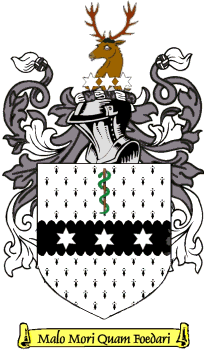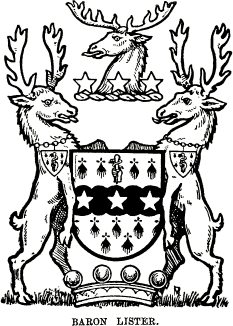

Coat-of-arms of Joseph Lister (1827-1912)
Baron
Joseph Lister of Lyme Regis
The above depiction of the coat-of-arms of Joseph Lister is due to Stephen Plowman.
[ © 2004
Stephen Plowman. This
copyrighted image is
reproduced here by permission. ]


Ermine, on a fess invected Sable three mullets of six points Argent,
in chief a staff of Aesculapius erect Proper.
Crest :
A stag's head erased Proper, in front thereof three estoiles fesswise Argent.
Motto :
Malo mori quam foedari.
[I'd rather die than be disgraced.]
Baronet in 1883. Baron in 1897.

References:
![HAND holding staff
is an artistic license [?]](staff.gif)
- Harleian Society - Grantees of Arms (1687-1898)
Lister, Sir Joseph, Bart., of London, 1884, Vol. LXII, fol. 184;
Supporters (Baron Lister), 1897. Vol. LXIX, fol. 267.
- Burke's General Armory - Supplement
Lister (Bart., of Park Crescent, m. Middlesex).
Erm. on a fess invected sa. three mullets ar. in chief a caduceus* ppr.
Crest-A stag's head erased ppr. in front thereof three mullets fesswise ar.
Motto-Malo mori quam foedari.
(*) The correct charge is a
staff of Aesculapius (single serpent, symbol of medicine)
not a caduceus (two serpents, symbol of commerce).
The above references were kindly provided by Stephen Plowman.
Joseph Lister, 1st Baron Lister, Bt., OM, FRS, PC
made his mark as a surgeon and a pioneer of antiseptic surgery.
He was born on 5 April 1827 in Essex, to an n affluent Quaker family.
His father, Joseph Jackson Lister, FRS (1786-1869)
is remembered for perfecting the optical microscope by designing achromat object lenses combining crown and flint glass elements
(Lister Sr. did this while engaged full-time as a wine merchant).
 Applying the ideas put forth by
Louis Pasteur (1822-1895)
Joseph Lister (1827-1912) introduced antiseptic surgery
at the Glasgow Royal Infirmary.
He promoted the use of carbolic acid
(phenol)
to clean wounds and sterilize surgical instruments.
This made surgery safer by greatly reducing post-operative infections.
Joseph Lister was made a Baronet in 1883 and became a Baron in 1897.
He passed away on 10 February 1912.
Applying the ideas put forth by
Louis Pasteur (1822-1895)
Joseph Lister (1827-1912) introduced antiseptic surgery
at the Glasgow Royal Infirmary.
He promoted the use of carbolic acid
(phenol)
to clean wounds and sterilize surgical instruments.
This made surgery safer by greatly reducing post-operative infections.
Joseph Lister was made a Baronet in 1883 and became a Baron in 1897.
He passed away on 10 February 1912.












